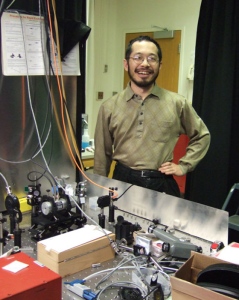Tags
Beethoven, brain, Chopin, diaphragm, ear, emotions, Fantaisie-Impromptu, Gottfried Schlaug, guitar, Harvard University, Jupiter, magnetic resonance imaging, Max Planck Institute, neuroscience, piano, pitch, Proceedings of the National Academy of Sciences, rhythm, Ryohei Yasuda, Stacey Singer, Steinway & Sons, The Juilliard School, The Neuroscientist, The Palm Beach Post, throat, violin, Yoonie Han

Ryohei Yasuda
Once the tap-tapping of the piano tuner finally ceased, the halls of Max Planck Florida Institute for Neuroscience fell silent. But before Juilliard artist Yoonie Han arrived for the first of four “Science Meets Music” concert/lectures at the Jupiter [FL] institute, a scientist sat down at the keys and delivered a performance to be remembered.
At the piano was the institute’s soft-spoken scientific director, Dr. Ryohei Yasuda, whose breakthrough research on the biochemistry of short-term memory recently made the pages of a prestigious journal, PNAS, the Proceedings of the National Academy of Sciences. Yasuda admired the piano’s inner machinery, its sleek black wood. He recalled his childhood in Japan, and a mother who demanded he spend an hour a day practicing. He resented it then, but things changed as he grew into his teens and the music of Chopin, Beethoven and Bach opened to him. And so at the first opportunity that chilly January day, he placed his fingers on the Steinway’s keys, and straight from his memory, played Chopin’s Fantaisie-Impromptu.
One by one, scientists left their benches and computers and stepped in to listen. When Yasuda’s fingers finally rested, the hall shook with applause, and he looked up, amazed that a crowd had gathered.
A neuroscientist and an accomplished musician. How could one person be both? It’s a question that has occupied many researchers: Does the study of music increase intelligence or improve creativity?
Harvard neurology professor Dr. Gottfried Schlaug has investigated it for many years. Functional MRI and other technologies have illuminated just how specialized areas of the brain are. Above the ear, for example, is where the auditory cortex lies. Within it, specialized bundles of neurons respond to precise frequencies of sound, each tuned to its own range. However, to perform beautiful music, Schlaug notes, the brain must perform a multitude of integrated, complex tasks, all linked to this auditory cortex, going far beyond the simple recognition of pitch.
Singing, for example, requires verbalizing words, knowing language, and moving the diaphragm to force air through the throat, while tightening and relaxing muscles to achieve correct pitch. It requires a sense of rhythm and cadence, a sensitivity to volume, and even an expression of emotion. It demands detailed memory of how a piece should sound and the ability to visually glean meaning from dots and lines on a page. Playing a guitar, piano or violin requires the brain to do all of this while simultaneously directing precise movements of fingers, hands, arms and shoulders.
How does the brain manage all of this?
New advances in imaging technology are allowing scientists to go beyond functional MRI and begin to actually see thoughts in real time, to see the specialized networks of nerve bundles work together to store memories and activate motion.
Harvard’s Schlaug has found that those who started learning to play an instrument as a child develop brains that are different. They contain more gray matter – especially in an area called the corpus callosum, which is where the parts of the brain that respond to sensory stimuli and initiate movement meet. Hearing music lights up many more sections of their brains, on both sides, especially the inferior frontal gyrus, a region involved in speech and quick decision-making. They also may have important differences in white matter, the “cables” of the brain, which transmit instructions among regions, allowing coordination. In certain areas, musicians’ white matter architecture shows greater alignment and stronger connections. In a review for The Neuroscientist, Schlaug suggested this may underlie studies that have found higher IQs among musicians trained as children and greater mathematical ability. Music-making shows promise as a treatment of brain and developmental disorders, he noted.
Yasuda believes that his mother’s demands that he practice every day prepared his brain not just for music, but for his scientific career. “I think probably the practice process is something important for development. It requires patience, involvement, commitment for many hours. These are all important to do research,” he said.
Stacey Singer – The Palm Beach Post
